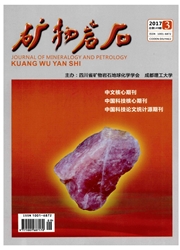

 中文摘要:
中文摘要:
选择青藏高原南部邛多江盆地湖相沉积物为研究对象,利用AMS14C测年手段,建立邛多江盆地湖相沉积物40kaBP~30kaBP的时间序列。对采自5cm~250cm湖相沉积物中的50件样品进行总有机碳(TOC)含量、总氮(TN),TOC/TN比值和有机碳同位素(δ13C)等环境代用指标的测试分析,将邛多江盆地40kaBP-30kaBP期间的古气候划分为如下几个阶段:气候暖湿期(40.2kaBP~38.5kaBP)、气候温干期(38.5kaBP~35.4kaBP)、气候过渡期(35.4kaBP~32.4kaBP)、气候动荡期(32.4kaBP~31.7kaBP)和气候转干期(31.7kaBP~30.3kaBP);经频谱分析表明,研究区存在1552a,1187a,961a,602a,538a和492a气候变化的准周期,千年尺度的气候变化可能与太阳活动、大气环流、大洋内部不稳定因素的影响及季风的活动周期有关,识别出的538a周期与太阳活动的530a周期相对应,可能表明太阳活动也是影响藏南邛多江盆地气候变化的原因之一。
 英文摘要:
英文摘要:
The lacustrine sediments of Qiongduo Basin in the southern Qinghai-Tibet Plateau are studied by using AMS14C dating method,and the time series of 40 ka BP-30 ka BP of Qiongduo- jiang basin sediments is obtained. The TOC content, TN, the TOC/TN ratio and δ13 Corg substi- tute indexes from 50 samples of 5 cm-250 cm Qiongduoliang Basin lacustrine sediments are analyzed,and the paleoclimate change of 40 ka BP-30 ka BP in Qiongduojiang Basin is divided into several stages: the warm humid climate period (40.2 ka BP-38.5 ka BP) ,the warm arid climate period (38.5 ka BP-35.4 ka BP), the transition climate period (35.4 ka BP-32.4 ka BP) ,the volatility climate period (32.4 ka BP~31.7 ka BP) and shift to arid climate period (31.7 ka BP- 30.3 ka BP). Spectrum analysis reveals that there are quasi-periodic climate variations of 1 552 a, 1 187 a,961 a,602 a, 538 a and 492 a from 40 ka BP-30 ka BP. Climate change at the millennium scale may be related to the effects of solar activity, atmospheric circulation, oceanic internal instability and monsoon activity. The identified 538 a cycle corresponds to the 530 a cycles of the solar activity, and therefore,the solar activity is also one of the causes of climate change in the Qong- duojiang basin.
 同期刊论文项目
同期刊论文项目
 同项目期刊论文
同项目期刊论文
 期刊信息
期刊信息
